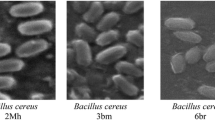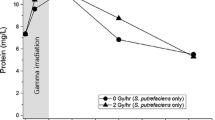Abstract
The radiotoxicity of plutonium in NTA-degrading Chelatobacter heintzii cell suspensions was investigated as part of a more general study to establish the key interactions between actinide-organic complexes and microorganisms in the subsurface. The radiation tolerance of C. heintzii, based on 60Co gamma irradiation experiments, was 165 ± 30 Gy. No bacteria survived irradiation doses greater than 500 Gy. In the presence of plutonium, where alpha particle decay was the primary source of ionizing radiation, the observed toxicity was predominantly radiolytic rather than chemical. This was evident by the greater effect of activity, rather than concentration, on the toxicity noted. Bioassociation of plutonium with C. heintzii was postulated to be an important and necessary step in the observed loss of cell viability since this was the best way to account for the observed death rate. The radiotoxicity of plutonium towards bacteria is a potentially important consideration in the bioremediation of sites contaminated with radionuclide-organic mixtures and the bioprocessing of nuclear waste.
Similar content being viewed by others
References
Banaszak JE, Reed DT & Rittmann BE (1998) Speciation-dependent toxicity of neptunium(V) towards Chelatobacter heintzii. Environ. Sci. Techn. 32(8): 1085–1091
Banaszak JE, Reed DT & Rittmann BE Subsurface interactions of actinide species and microorganisms: implications for the bioremediation of actinide-organic mixtures. J. Radioanal. Nuclear Chem., accepted for publication
Banaszak JE, VanBriesen JM, Rittmann BE & Reed BE (1998) Mathematical modeling of the effects of aerobic and anaerobic chelate biodegradation on actinide speciation. Radiochim. Acta 82: 445–451
Bolton HJ, Girvin D, Plymale A, Harvey S & Workman D (1996) Degradation of metal-nitrilotriacetate complexes by Chelatobacter heintzii. Env. Sci. Tech. 30(3): 931–938
Draganic IG & Draganic ZD (1971) The Radiation Chemistry of Water, Academic Press, New York, p. 153
Egli T (1994) Biochemistry and physiology of the degradation of nitrilotriacetic acid and other metal complexing agents. In: Ratledge C (Ed) Biochemistry of Microbial Degradation (pp 179–195). Kluwer Academic Publishers, New York
Ewing D (1976) Effects of some OH scavengers on the radiation sensitization of bacterial spores by p-nitroacetophenone and O2 in suspension. Int. J. Radiat. Biol. 30: 419–432
Ewing D (1982a) Oxygen-dependent damage involving OH radicals in irradiated bacteria. Int. J. Radiat. Biol. 42: 191–194
Ewing D (1982b) Hydroxyl radical damage in low oxygen concentrations in irradiated bacteria. Int. J. Radiat. Biol. 41: 203–208
Ewing D (1987) Application of radiation chemistry to studies in the radiation biology of microorganisms. In: Farhataziz & Rodgers MAJ (Eds) Radiation Chemistry Principles and Applications (Chapter 17). VCH Publishers, Inc., New York
Johansen I & Howard-Flanders P (1965) Radiat. Res. 24: 184
Okajima S & Reed DT (1993) Initial hydrolysis of Pu(VI). Radiochim. Acta 60: 173–184
Reed DT & Okajima S (1994) Stability and speciation of plutonium(VI) in WIPP brine. Radiochim. Acta 66/67: 95–101
Reed DT, Aase S, Wygmans D & Banaszak JE (1998) The reduction of Np(VI) and Pu(VI) by organic chelating agents. Radiochim. Acta 82: 109–114
Riley RG & Zachara JM (1992) Chemical contaminants on DOE lands and selection of contaminant mixtures for subsurface science research. DOE/ER-0574T. U.S. Department of Energy, Office of Health and Environmental Research, Washington, D.C.
Rittmann BE & VanBriesen JM (1996) Microbiological processes in reactive transport modeling. In: Lichtner PC, Steefel CI & Oelkers EIH (Eds) Reviews in Mineralogy, Vol 34: Reactive Transport in Porous Media (pp 311–334). Mineralogy Society of America
Spinks JWT & Woods RJ (1976) An Introduction to Radiation Chemistry. John Wiley and Sons, New York, pp 93–98
Wildung R, Garland, ETR & Rogers JE (1987) Plutonium interactions with soil microbial metabolites: Effect on plutonium sorption by soil. In: Environmental Research on Actinide Elements (pp 1–25). CONF-841142
Wildung RE & Garland TR (1982) Effects of plutonium on soil microorganisms. Appl. Environ. Microbiol. 43(2): 418–423
Wildung RE & Garland TR (1980) In: Hanson WC (Ed) The Relationship of Microbial Processes to the Fate and Behavior of Transuranic Elements in Soils, Plants, and Animals, Transuranium Elements in the Environment. DOE/TIC-22800
U.S. Department of Energy (DOE) (1990) Subsurface science program: Program overview and research abstracts, FY 1989–1990. DOE/ER-0432, U.S. Department of Energy, Washington, D.C.
Author information
Authors and Affiliations
Rights and permissions
About this article
Cite this article
Reed, D., Vojta, Y., Quinn, J. et al. Radiotoxicity of plutonium in NTA-degrading Chelatobacter heintzii cell suspensions. Biodegradation 10, 251–260 (1999). https://doi.org/10.1023/A:1008317709183
Issue Date:
DOI: https://doi.org/10.1023/A:1008317709183




